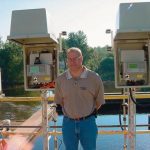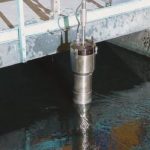The Kalamazoo Wastewater Treatment Plant (KWRP) currently discharges to the Kalamazoo River. Flow into the KWRP is approximately 27 million gallons per day. Approximately half (50 %) of the plant’s organic load comes from one pharmaceutical company with 50 % of soluble phosphorus loading resulting from two local industries. With this combination a potential for large and unpredictable phosphorus loading exists.
The plant uses a combination of biological and chemical techniques for phosphorus removal by dosing ferric chloride to precipitate soluble phosphorus. The plant has always relied on laboratory results to dictate appropriate actions with respect to the control of chemicals for phosphorus removal and the corresponding impact on effluent quality. To provide a faster and more economical means of controlling chemical addition for phosphorus removal, the plant wished to install a continuous online monitoring system. In the autumn of 2003 the city opted to evaluate the Stip Isco Helios Phosphate (PO4-P) buoy system to measure the concentration of phosphate in its final effluent.
Every 6 to 8 minutes
The Helios process buoy measures phosphate in wastewater using continuous batch analysis, typically in aeration basins, activated sludge or final effluent. The measurement cycle, using photo-optical detection, occurs at intervals of 6 to 8 minutes. Automatic, dual-standard calibration and automatic self-cleaning allow continuous, maintenance-free operation for 4 to 6 weeks.
The sample is pulled through an in situ onboard filtration device to remove solids. The phosphate reaction is based on the ascorbic acid method (EPA 365.1 and Standard Method 4500-P E). Within the optical cell, the sample is then analysed for light absorption with a dual-diode light source. The full range of phosphate content is evaluated at a wavelength of 525 nm, based on a polynomial algorithm. Lower concentrations are also evaluated at the more sensitive wavelength of 732 nm, based on a linear calibration.
Directly in final effluent
In addition to controlling the chemical analysis and parameter measurement, the onboard computer with its graphical user interface assumes operational control of all maintenance and test routines. Multitasking capability allows simultaneous handling of special and routine operations. For example, the operator can recall and view or print the stored parameter charts and maintenance data of the last 14 days without interrupting the ongoing analysis and data acquisition. The built-in floppy disc drive allows storage of 90 days of data on a single diskette. Data can be easily imported into popular spreadsheet programs like Excel and retrieved remotely via the phone line.
It is generally accepted that 30 to 40 % of the cost of a conventional online cabinet-style wastewater analyzer can be directly related to infrastructure such as piping and pumping installations. These are costs over and above those for the equipment itself. The unique design of the Stip Isco process buoys eliminates the need for pumps in the wastewater as well as for external online filtration devices, expensive pipework and analyzer shelters.
The buoy package is designed for installation outdoors and can be in place within a few hours, which makes it particularly well suited to existing treatment plants and industrial applications.
Ron Janssen, Pilot Plant Supervisor at Kalamazoo WWTP, comments: “The comparison of manually collected samples with concentrations indicated by the Stip Isco process buoy was excellent. The analyzer performed flawlessly over a period of 4 weeks without any manual intervention. We have since purchased the analyzer and expect many years of reliable and accurate measurement. We also intend evaluating the Stip Isco ammonia buoy. The existing controller has the unique ability to measure both phosphate and ammonia simultaneously.“
cpp 472
Share:








